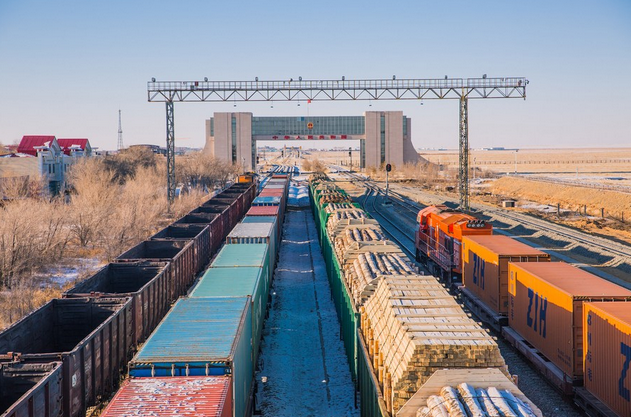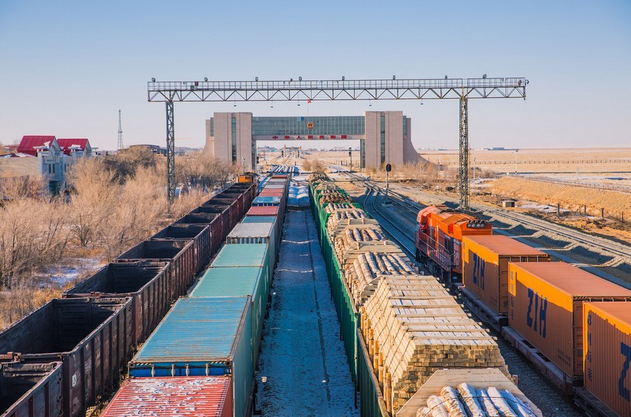
Photo taken on Jan. 8, 2021 shows freight trains at Erenhot Port in north China's Inner Mongolia Autonomous Region. (Photo by Guo Pengjie/Xinhua)
BEIJING, March 10 (Xinhua) -- China-Europe freight train service, as an important pillar for the Belt and Road Initiative (BRI), has shown strong vitality.
In January, the total number of China-Europe freight train trips hit the record high of 50,000. In 2021 when transportation by air and sea were blocked, the service offered a lifeline for the distribution of anti-virus materials and ensured smooth international logistics.
Such service not only plays a significant role in China's foreign trade and economic cooperation, but also releases the potential of land logistics and trade in Asia and Europe, creating more new space for the development of countries and regions in the two continents.
As its integration with cross-border e-commerce platforms, logistics platforms, bonded platforms and pilot free trade zones accelerates, China-Europe freight train service is expected to usher in high-quality development.
--Growth despite pandemic
China-Europe freight train service experienced fast growth last year. Data from the General Administration of Customs (GAC) showed that the number of China-Europe freight train trips rose 22 percent year on year to hit 15,000 in 2021.
The increase could be attributed to relatively low costs and high transportation efficiency compared with transport by air and sea, said Bai Ming, deputy director with the international market research department of the Chinese Academy of International Trade and Economic Cooperation under the Ministry of Commerce (MOC).
Meanwhile, China-Europe freight train service has offered a lifeline for the distribution of anti-virus materials. By the end of November 2021, 13.43 million pieces of epidemic prevention materials weighing 103,000 tonnes had been transported via China-Europe freight trains.
Another main factor driving the growth of China-Europe freight train service was the booming trade between China and the European Union (EU). GAC's data showed that China's trade with the EU in 2021 amounted to 828.11 billion U.S. dollars, up 27.5 percent year on year. China remained the EU's largest trading partner, while the EU was China's second largest trading partner.
--Strong support for BRI
Running through Asia and Europe, China-Europe freight trains have been boosting trade between countries and regions involving in the BRI.
As of January, China-Europe freight trains with 78 routes planned have reached 180 cities in 23 European countries, significantly facilitating the trade between China and the Belt and Road (B&R) countries.
The operation efficiency of the trains has been greatly improved over the past few years. Statistics showed that the total transit time was shortened from 24 days in the very beginning to 12 days.
More types of goods were transported via China-Europe freight trains. According to data from the United Transport and Logistics Company Eurasian Rail Alliance, 80 percent of China's exports to Europe three years ago were electronic products, mechanical products and automobile parts. In the first half of 2021, these three types of commodities accounted for only about 40 percent of the total goods transported, while the share of chemical products like plastics, rubber and glass increased rapidly. The transportation volume of medical and health products also showed a growth momentum.
For cities participating in the BRI, the importance of the construction of China-Europe freight train lies in the economic and trade chain formed thereafter that leads the industrial transformation and upgrading of relevant regions.
For example, coal and steel used to be the pillar industries of Ruhr industrial base of Germany. Since the launch of China-Europe freight train under the BRI, local modern services like logistics, automobile, machinery manufacturing, iron and steel industries have seen robust growth.
-- New models of "China-Europe freight train plus"
New models of "China-Europe freight train plus" have grown out of China-Europe freight train service in recent years.
On September 1 of 2020, a China-Europe freight train for cross-border e-commerce B2B exports departed from southwest China's Chongqing Municipality and was bound for Germany, Poland, and other European countries. The launch of the cargo freight service, marking the first of its kind, blazed a new trail for foreign trade.
Statistics from the GAC showed that China's cross-border e-commerce imports and exports in 2021 climbed 15 percent year on year to 1.98 trillion yuan, with the exports reaching 1.44 trillion yuan, up 24.5 percent.
In addition, the trains customized for cross-border e-commerce along the routes of SCO demonstration zone-Minsk, Yiwu-Xinjiang-Europe, Suzhou-Xinjiang-Europe, Hefei-Hamburg and Wilhelmshaven were successively launched.
The multi-model transport in cooperation with local carriers significantly improved the efficiency of the China-Europe freight trains, Bai Ming said. He added that a large number of cross-border e-commerce enterprises, logistics service providers and digital startups with demand of overseas warehouses are gathering in the cities where the trains stop. Under the model of "cross-border e-commerce B2B + China-Europe freight train + overseas enterprise/warehouse", foreign trade companies can get access to the global market in an easier and more effective way.
As of December 2021, China had over 2,000 overseas warehouses covering a total floor area of over 16 million square meters, according to Li Xingqian, head of the foreign trade department of the MOC.
Thanks to the widespread overseas warehouses and highly cost-efficient China-Europe freight trains, more European people have benefited from China's e-commerce service during the pandemic. Statistics showed that in the past two years, the number of Polish people shopping through cross-border e-commerce increased 13 percent, and over one fourth of Polish people have become users of China's e-commerce platforms.
As a transcontinental, cross-country, long-distance and high-capacity way of transportation, China-Europe freight train has become an international public product and international cooperation platform widely recognized by countries involved. In the future, China-Europe freight train plus other sector like culture and tourism is expected to propel cooperation in wide range of areas such as international trade, two-way investment, and people-to-people exchanges. (Edited by Su Dan with Xinhua Silk Road, sudan@xinhua.org)




 A single purchase
A single purchase









